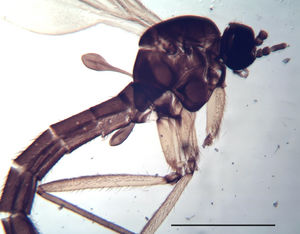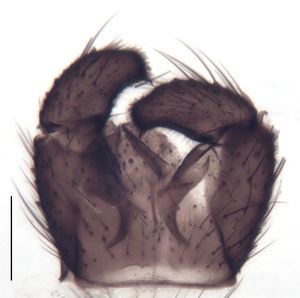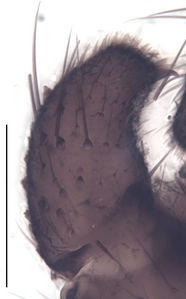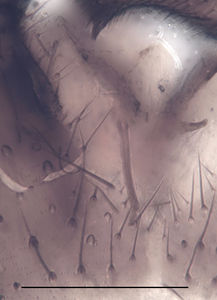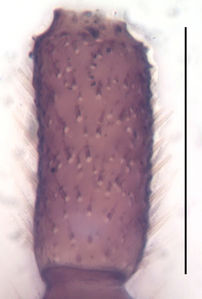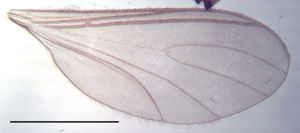Trichosiopsis fuscipalpa fuscipalpoides
Ordo: Diptera
Familia: Sciaridae
Genus: Trichosiopsis
Species: Trichosiopsis fuscipalpa
Name
Trichosiopsis fuscipalpa fuscipalpoides unpublished
Type material
Holotype: ♂, 16.5.–2.6.2014, Malaise trap, leg. Rulik, ZFMK-TIS-2564672 in ZFMK
Type locality
Germany, Rhineland-Palatinate, Niederzissen, Bausenberg
Barcoded material
| Stadium | Country | Province | Locality | Habitat | Method | Date | Collector | Collection Number | Collection | Latitude | Longitude | Elevation (m) |
|---|---|---|---|---|---|---|---|---|---|---|---|---|
| 1 ♂ | Germany | Rhineland-Palatinate | Niederzissen, Bausenberg | Wiese | Malaise Trap | 16.5.–2.6.2014 | Björn Rulik | ZFMK-TIS-2564672 | ZFMK | 50.465 | 7.226 | 292 |
| 1 | Germany | Rhineland-Palatinate | Bad Neuenahr-Ahrweiler, Landskrone | Malaise Trap | 25.07.2013 | Björn Rulik | BIOUG16219-G06 | ZFMK | 50.552 | 7.17 | 194 | |
| 1 ♂ | Germany | Hesse | Lorch a. Rhein, oberhalb der Burg Nollig | Trockenhang | Malaise Trap | 10.05.2013 | Oliver Niehuis | ZFMK-TIS-2527933 | ZFMK | 50.05 | 7.798 | |
| 1 ♂ | Germany | Rhineland-Palatinate | Bad Neuenahr-Ahrweiler, Landskrone | Forest | Malaise Trap | 02.06.2014 | Björn Rulik | BIOUG17094-B05 | ZFMK | 50.552 | 7.17 | 194 |
| 1 ♀ | Germany | Rhineland-Palatinate | Bad Neuenahr-Ahrweiler, Landskrone | Malaise Trap | 02.06.2014 | Björn Rulik | BIOUG17094-C01 | ZFMK | 50.552 | 7.17 | 194 | |
| 1 | Germany | Rhineland-Palatinate | Mayen-Koblenz | Forest | Malaise Trap | 16.05.2013 | Björn Rulik | BIOUG22302-F10 | ZFMK | 50.32 | 7.493 | 243 |
| 1 | Germany | Rhineland-Palatinate | Mayen-Koblenz | Malaise Trap | 29.05.2013 | Björn Rulik | BIOUG22303-H02 | ZFMK | 50.32 | 7.493 | 243 | |
| 1 | Germany | Rhineland-Palatinate | Mayen-Koblenz | Forest | Malaise Trap | 29.05.2013 | Björn Rulik | BIOUG22304-C11 | ZFMK | 50.32 | 7.493 | 243 |
| 1 ♂ | Germany | Rhineland-Palatinate | Niederzissen, Bausenberg | Wiese | Malaise Trap | 16.5.–2.6.2014 | Björn Rulik | ZFMK-TIS-2559687 | ZFMK | 50.465 | 7.226 | 292 |
| 1 ♀ | Germany | Rhineland-Palatinate | Niederzissen, Bausenberg | Trockenrasen | Malaise Trap | 24.04.2014 | Björn Rulik | ZFMK-TIS-2564781 | ZFMK | 50.465 | 7.222 | 321 |
| 1 ♂ | Norway | Buskerud | Hurum, Holtnesdalen | Malaise Trap | 07.07.2010 | L.O. Hansen | bf-sci-01334 | NHMO | 59.5409 | 10.4285 | 110 |
Description (male)
Head. Eye bridge 4 rows of facets. Antenna unicolour. LW-index of 4th flagellomere 2.3–2.8; neck 0.3–0.5 × segment width; transition of basal part to neck pronounced. Colour of neck unicolour. Antennal setae shorter than segment width; of normal strength; dense; salient. Palpus darkened; of normal length; palpomeres 3. First palpomere elongate; with 3–5 setae; with only sparse sensilla. Second palpomere short and oval. Third palpomere as long as first. Thorax. Colour brown. Notum unicolour. Thoracic setae normal; brown. Posterior pronotum setose. Postpronotal setae 1–4; fine. Mesothoracic sclerites bare. Legs. Colour yellow. Hind coxa of same colour as femora. Setae on front coxa darkened. Front tibial organ as patch of setae; dark; front tibial organ not bordered. Tibial setae on hind legs weak and inconspicuous. Tibial spurs of equal length. Claws untoothed. Wing. Wing slightly darkened; of normal shape, or with weakly developed anal lobe. Wing membrane without macrotrichia. Wing venation weak, with faint stM. M-fork of normal shape. R1 ending at or slightly before base of m-fork; posterior veins with macrotrichia; stM mostly with macrotrichia; CuA1 and CuA2 mostly with macrotrichia; bM bare; r-m with few setae, or mostly setose; bM:r-M 0.6–0.8; st-Cu:bM 0.4–0.8; R1:R 1.3–1.65; c:w 0.71–0.81. Halter darkened; of normal length. Abdomen. Abdominal setae strong; dense; on tergites black; on sternites black. Hypopygium concolour with abdomen; LW-index 0.6–0.75. Base of gonocoxites with weak setae; gonocoxites broadly separated; inner margin of gonocoxites typically U-shaped; inner membrane of hypopygium scarcely setose; ventral margin of gonocoxite with short setae. Gonostylus elongate; LW-index 1.75–1.96; Inner margin concave; apex with one obtuse angle. Apical tooth present; without internal structure; of medium strength. Awl-like setae normal; present beneath apical tooth. Megasetae absent. Whiplash-hair absent. Tegmen 0.6–0.82 × longer than broad; rectangular with rounded edges; without special features; central process absent. Length of ejaculatory apodeme/hypopygium 28–36 %; base of ejaculatory apodeme present. Field with aedeagal teeth inconspicuous. Measurements. Body size 2.8–3.6 mm. Hind tibia 1.5–1.7 mm. Wing length 2.5–3 mm.
Diagnosis
This species is based on its unique COI sequence. Tr. fuscipalpa fuscipalpoides is smaller than Trichosiopsis fuscipalpa fuscipalpa. It has a rather tumid gonostylus with a distinct apico-dorsal angle.
DNA Barcoding
The COI sequence is assigned to BIN BOLD:ACC1319 (average distance 0.09%, max. 0.17%, n=11, K2P: 8.21%).
Discussion
Trichosiopsis fuscipalpa fuscipalpoides is morphologically very similar to the other subspecies in the complex, but has the highest K2P of all. This alone might justify its consideration as a distinct species, but as the morphological distinction is not always possible, for practical reasons only subspecific rank is assigned to this taxon.
Etymology
The name refers to the similarity with Tr. fuscipalpa fuscipalpa.
Distribution
Germany, Norway.
Images
|
